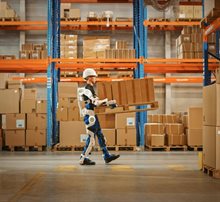Whitepaper ‘Labour Productivity Vital for Earning Capacity’
Thijmen van Bree and Joris Vierhout contributed to a TNO paper on what is needed to give labour productivity the necessary boost.
The inverted population pyramid is a demographic development we have all seen coming for a long time. But now it is here: more and more baby boomers are reaching retirement age, while there are nowhere near enough young people to compensate for the loss of these workers. This is a challenge for all EU countries, including the Netherlands. Moreover, labour participation in our country is currently so high that the maximum achievable has pretty much been reached. Meanwhile, there is more work than there are workers. And the demand for labour is only expected to increase further due to societal challenges, such as the energy transition, where ambitious goals must be achieved, and it is all hands on deck. It does not help that the growth of labour productivity in our country is stalling. Everything indicates that higher labour productivity is a crucial condition for the future creation of prosperity and well-being in the Netherlands.
Too Much Focus on Cheap Labour
Attracting more workers from abroad? Since the Dutch government is pursuing a discouragement policy on immigration, that does not seem like a realistic option. What remains is boosting labour productivity. “It helps enormously to look at the current situation through that lens,” says Thijmen van Bree, who works at TNO Vector as a researcher and consultant on economic issues. “Labour productivity growth in our country has been slowing down for years, and we are also doing worse than many comparable countries. So, there is still a lot to gain in that area. It is essential to use the production factors labour and capital in the most productive way. Why is that not happening at the moment? There are many causes, but what stands out is that there are many business models in our country that focus on minimizing costs. This leads to sectors that rely on cheap labour. Because these are labour-intensive activities, employment in such sectors grows rapidly without leading to the necessary growth in labour productivity. What needs to happen, in my opinion? Invest more in R&D and innovation and make sufficient funds available for lifelong learning and development of employees: that would really help to give labour productivity growth the necessary boost.”
The Machinery Industry as a Striking Example
Joris Vierhout, also an economist and also working at TNO Vector, sees more investments in R&D, innovation, and human capital very clearly as the way forward. According to him, innovative companies like ASML set a good example. “If you look at most of the industry in the Netherlands, you see that many industrial sectors hardly achieve productivity growth. But if you zoom in on the machinery industry, you see a strikingly good figure in that area.”
CBS figures (in Dutch) support this: in the period from 2020 to 2023, the machinery industry achieved labour productivity growth of 1.6 percent, while the rest of the industry did not get beyond a meagre 0.1 percent. And although CBS does not indicate where this remarkably large difference comes from, it is probably no coincidence that companies in the machinery industry do a lot of R&D, are very innovative, and their success largely depends on the knowledge, skills, and ingenuity of their employees. This requires significant investments, but then a flywheel effect can occur: the combination of R&D and constant attention to the training and development of employees increases the chances of successful innovations, which makes extra money available, part of which can be used for R&D and training, leading to new innovations, and so on. Essentially, the story of ASML in a nutshell. It is clear that investments in R&D and a clear innovation culture form a fertile basis for productivity growth. The big challenge for the Netherlands now is to translate the successful approach of machine manufacturers and their suppliers to other sectors.
AI and Robotics as a Solution?
In The Hague, the necessity of higher labour productivity has already been well understood. The cabinet is currently working on a productivity agenda with recommendations to help boost labour productivity in our country. Although it is still uncertain what those recommendations will be, it is likely that there will be a lot of attention to the possibilities of digitalisation – AI in particular – and robotics. These are at least directions explicitly mentioned in the coalition agreement. And in all this, one thing is already certain: it will be a challenge to get SMEs on the desired growth path. Compared to large companies, SMEs invest less in R&D and are less likely to choose innovative technology to increase their productivity. “This is partly because many business activities in the Netherlands rely on cheap labour,” Van Bree explains. “Moderating wages and using labour flexibly: that has characterised Dutch labour market policy for decades. But if labour is so cheap, you remove all incentives to invest in the development of employees.”
Collaboration Between Humans and Machines
What Van Bree wants to say is that automation is only part of the solution and that it is equally important to ensure that human labour is valued. “In some sectors, you can go a long way with AI, robots, and other labour-saving technology, but there is also a lot of labour-intensive work in our country that you cannot easily digitalise or robotise. If you look at healthcare and education, for example, there is less room to use innovative technology to increase labour productivity. And in places where digitalisation and robotics can make a big difference, you need people who know exactly how to handle that technology correctly. This means that investments are also needed to retrain or upskill employees. Using new technology is one thing, but successfully applying it is only possible if humans and machines can work well together.”
A Mix of Measures Needed
The government can steer towards higher labour productivity with new innovation policy, but Van Bree indicates that there is no such thing as a quick fix. “A mix of measures is needed, both from the government and from the business sector itself, with the approach differing per sector. The problem is now so deeply rooted that a fundamental change in the labour market is needed to break that situation. In fact, to achieve sustained faster growth in labour productivity in the Netherlands, a structural change in the economy is needed. This is a drastic and complex process that will take a lot of time. Meanwhile, there are already things that can be quickly addressed, such as adjusting the way companies recruit new employees. By looking less at diplomas, for example, and more at skills and potential, people can move more quickly across the labour market and take on suitable work. But also: offering employees within a company enough opportunities to develop further. In this way, as a company, you can take the first steps in the desired direction. People are not robots. The downside is that they cannot work non-stop, 24/7, but the advantage of people is that they can grow in their work and actively think about smarter ways to achieve better results. In this way, they can contribute to continuous innovation and productivity improvement. But they must be given the space to do so.”
Read more about what is needed to give our labour productivity the necessary boost (in Dutch).
Want to know more? Contact us






